|
Every year there's increasing pressure from some segments of the angling public to
institute a catch and release policy for all rainbow trout. It hasn't happened yet,
but the Alaska fishing regulations do state, " . . .all rainbow trout less than 30 inches
must be released immediately . . ." Good lord, you think to yourself, what kind of
river has regulations like that? Well, for starters, it has to have some 30-inch
rainbow trout.
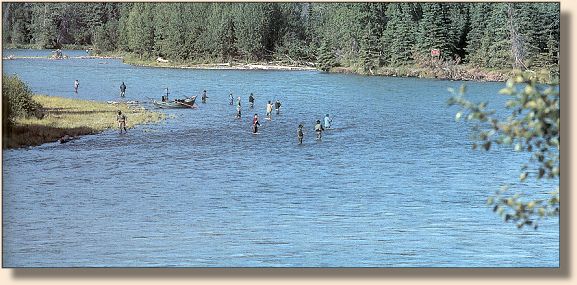
Welcome to the Kenai River. A river where there are rainbow trout which
exceed 30 inches in length as well as Dolly Varden that approach similar
proportions. And if that's not enough, there's also the annual parade of
Pacific salmon.
The Kenai River lies 120 road miles south of Anchorage and is the centerpiece
of the Kenai Peninsula. Even though southeast Alaska my be the saltwater troller's
paradise and southwest Alaska's Bristol Bay drainage is a top notch destination for
those anglers who fish all over the world, in a way, it could be said that the Kenai
River is also the centerpiece of Alaskan angling. Surely it's not as remote as other
areas, but that is partly responsible for its well deserved popularity. It is because
the Kenai Peninsula and the Kenai River are - unlike most of Alaska - accessible
by road that makes it the realized dream of Alaska fishing. It is a reality for those
who logistically and monetarily cannot make the trip to Alaska's more glorified,
and remote, waters.
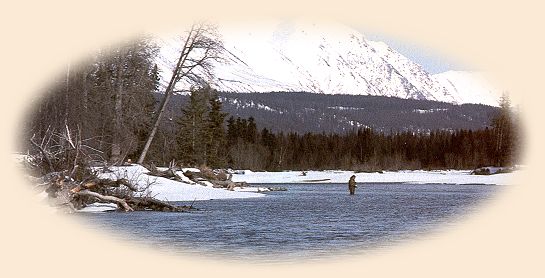
The Kenai Peninsula was not always road accessible. This once roadless tract of
wilderness was home to the Kenaitze people who flourished unchanged among its
natural resources until the appearance of two ships, the Resolution and the Discovery.
The year was 1778 and with them was the intrepid explorer Captain James Cook.
Although Cook claimed the country in the name of England, Russia, as well as
French and Spanish vessels, had also been exploring Alaska's coast at that time.
By the 1780s the entire Cook Inlet region had been claimed by Russians. Trading
post and contacts with these foreigners changed the life of these nature people forever.
The Russian Orthodox church replaced the shamanistic religion of the Kenaitzes,
and by 1840 smallpox decimated the native population.
Soon after this the Russians began searching for gold - and found some in the area
of what are now the Kenai River tributaries of Russian River and Cooper Creek..
In the 1880s Joseph Cooper also searched for gold and Cooper Landing, a town
on the Kenai River near the outlet of Kenai Lake, now bears his name. Shortly
after the turn of the century a gold rush was on to the areas of Hope and Sunrise
which lie to the north of the Kenai River on the shores of Turnagain Arm.
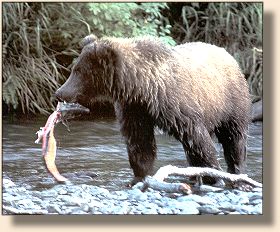
Even with the promise of gold, the Kenai Peninsula was still relatively
inaccessible, and it wasn't until 1904 that the first railroad spike was driven
at the seaport of Seward to begin the rail line that would connect it with
Anchorage. By 1938 Cooper Landing was connected by road to Seward,
and finally in 1951 the road from Anchorage to Cooper Landing and on to
the town Kenai was officially opened. Traffic on the road greatly increased
at the end of the decade with the Swanson River oil discovery near the town
of Kenai.
This began the period of the Kenai Peninsula's most dramatic change. Fish and
game resources of the Kanai Peninsula bent under the pressure from inroads of
development and the influx of people. The resiliency of the natural resources
enabled them to survive human intrusion and development just as they had also
managed to withstand prior events such as floods, great fires, volcanic ash fallout
and the tremendous earthquake of 1964.

The floura, fauna and landscape came through this early history relatively
unscathed, and to the casual observer it would seem that sporting opportunities
of the peninsula were developed only coincidentally with the road access of its
more recent history. This is not true. As early as 1911 there were 24 registered
hunting guides on the Kenai Peninsula, and in 1918 in his USDA report title
Report on a Reconnaissance of the Soils, Agriculture, and Other
Resources of the Kenai Peninsula Region of Alaska, Hugh H.
Bennet wrote,
"The streams abound with trout and grayling. Russian River has the reputation of
being one of the best fishing streams in Alaska. The writer had excellent fishing in
this and also other streams, particularly Ptarmigan Creek, near the head of Kenai
Lake, and in some streams near Seward. Dolly Varden and rainbow trout are
very numerous."
It is understandable why the Russian River already had such a reputation, and its
confluence with the Kenai River still remains an angling hot spot. The reason is simple.
The Russian River is a clearwater stream and the Kenai River is glacially silted. The
clear water of the Russian River afforded such a clear view of the rainbow trout, Dolly
Varden and salmon that entered it, that the clear water and sometimes plainly visible
fish became an open invitation to anyone - angler or not - who stood on its banks.
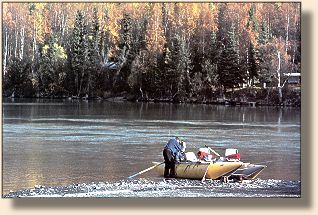 Meanwhile the blue-green tinted water of the Kenai remained an unknown. It
wasn't until later - essentially the 1960s - when anglers realized that the silted
water of the Kenai River could be fished with lure or fly just as successfully as
clearer, most traditional looking, waters could.
Meanwhile the blue-green tinted water of the Kenai remained an unknown. It
wasn't until later - essentially the 1960s - when anglers realized that the silted
water of the Kenai River could be fished with lure or fly just as successfully as
clearer, most traditional looking, waters could.
The ultra-fine silt that gives the Kenai River its chalky blue-green color - which
defies accurate description because it changes with the seasons and the amount
and angle of sunlight - stretches from the river's glacial beginnings to its finale
where it meets the saltwater of Cook Inlet. While the color may remain throughout
the river's length, the Kenai is by no means a homogeneous ribbon of water from
start to finish. In fact, major portions of the river are so completely different that,
from an angling standpoint, they can almost be treated as entirely different rivers.
Officially the Kenai River begins at the Sterling Highway bridge. From the 20 mile
long, mile wide, nearly boomerang shaped Kenai Lake, the river flows westward
to Cook Inlet. A bird's eye view [for a MAP of the region, click
here.] shows
that the Kenai River's most prominent feature is that not only does it begin at a
lake but it dumps into and spills out of another large lake - Skilak Lake - a fifth
of the way down its length. Skilak Lake, this lake in the middle, stretches for
15 miles and averages about four miles wide, and like Kenai Lake, its waters
are colored blue-green from suspended glacial silt.

The Kenai River would not exist as it does without the complimenting factors provided
by these two lakes. They are breeding cauldrons for zooplankton, which in turn is
the preferred food of juvenile sockeye salmon. Consequently, Kanai and Skilak lakes
are the nursery area for millions of juvenile sockeye salmon. And this jump in biomass,
from zooplankton to sockeye salmon, is a large factor in the complicated food web that
affects everything from rainbow trout to bald eagles.
The lakes also act as winter sanctuaries. While it has been found that 90% of
all juvenile king and silver salmon are found along the undisturbed banks and
associated wetlands of the lower river, at the end of their first year they swim
upstream to overwinter in Skilak and Kenai Lake. Most of the adult rainbow
trout and Dolly Varden also head to one of the lakes at the onset of winter's
harsh weather.
Fishing Season
The fishing season on the Kenai River typically gets underway during the month of
May. The four miles of water upstream from the Upper Kelley River are closed
to all fishing to protect spawning rainbow trout. Downstream reaches are open
to fishing, but it is king salmon, not rainbow trout, that draws anglers to the lower
Kenai in May.
The first waves of king salmon begin to enter the river in mid-May and with them
come equally large waves of anglers. From May through July tens of thousands of
king salmon will enter the freshwater of the Kenai River. Although some kings will
migrate far into the system, sometimes even entering very small tributary streams,
the bulk of the kings stay in the lower river. It is here that a flotilla of power boats
hunt for that huge trophy king salmon for which the Kenai River is world renowned.
The few kings that venture into smaller tributary streams and those that migrate beyond
Skilak Lake are protected by regulation.
Both bank-bound and boat anglers who use fly tackle and do manage to hook kings
here - landing them is another matter completely - favor fast sinking-tip lines and
shooting heads. The sinking-tips are the variety with longer than average tip sections,
generally 15 to 25 feet in length, and are made with lines of the fastest sink rate. Even
so, in many cases these lines are not adequate. They are not able to slice through the
current and get a fly down to a king salmon.
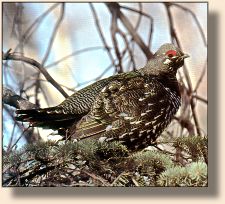 Fly fishers who fish for king salmon generally agree that getting the fly in front of the fish
is much more important than the fly pattern that is being used. Bright or fluorescent
orange - often in combination with fluorescent green or chartreuse - is the dominate
color of flies used for kings. In short, anything big and orange is considered a suitable
fly for kings. A prototypical fly that does a good job of capturing the spirit of fly fishing
for Kenai River king salmon is an obnoxious pattern called the Fat Freddie. It's a golf
ball-sized clump of orange yarn with a plume of white marabou - and maybe a spritzer
of silver Krystal Flash - tied on a 1/0 hook. For the FLIES for the Kenai, click
here.
Fly fishers who fish for king salmon generally agree that getting the fly in front of the fish
is much more important than the fly pattern that is being used. Bright or fluorescent
orange - often in combination with fluorescent green or chartreuse - is the dominate
color of flies used for kings. In short, anything big and orange is considered a suitable
fly for kings. A prototypical fly that does a good job of capturing the spirit of fly fishing
for Kenai River king salmon is an obnoxious pattern called the Fat Freddie. It's a golf
ball-sized clump of orange yarn with a plume of white marabou - and maybe a spritzer
of silver Krystal Flash - tied on a 1/0 hook. For the FLIES for the Kenai, click
here.
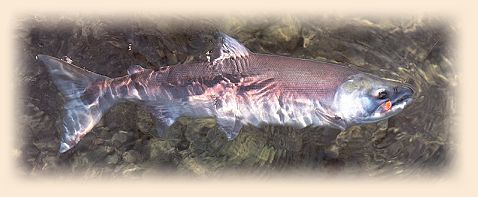
Sockeye Salmon
As fishing for sockeye salmon became more popular, more and more anglers became
aware that sockeyes could indeed be taken by more sporting methods. [Commonly taken
by snagging.] Sockeye salmon will, in fact, strike flies, but for some anglers there are
two major hurdles to overcome before they ascribe to this notion.
For starters, ninety-nine percent of the anglers fishing for sockeye use the aforementioned
bi-colored bucktail known as the Coho Fly. It is tied on a Mustad #36717, size 4 hook,
the completed fly is tied very full and is usually about three inches in length. There is always
a raging debate as to what particular color combination is best. [Since most are snagging
it doesn't make a difference!]
To further complicate matters, even if you are using a pattern that is appropriate for
sockeye salmon, it's quite likely that you may go for long periods of time without a
strike. Although there are those extreme cases when it seems as though sockeyes
will strike at nearly anything that drifts by them, for the most part, sockeyes are not
aggressive. Even when they are in a taking mood, they'll usually only drift slightly to
one side, delicately mouth the fly for an instant and then eject it.
Anglers with appropriate fly patterns, skill and desire regularly have sockeye salmon
strike their flies. The tactics used are not overly difficult to master and the most critical
being the depth at which the fly is presented. The fly - throughout the entire drift if
possible - should remain at the same level at which the fish are holding. While
sockeyes frequently roll on the water's surface just as other salmon species do,
they almost never move up in the water column to strike a fly. Drifting a fly a foot
or two above a school of holding sockeyes is usually about as effective as fishing
with no fly at all.
Trout Fishing
Unlike some of the classic fly fishing water in the country, the Kenai River's seasonal
highlights are not driven by insect emergences, and you will not find tables and charts
delineating the appearance of drakes and duns and spinner falls. The river, however,
does have a tremendous seasonality about it, but it is the salmon which drive the system.
So, even if you are not interested in catching salmon, you must pay close attention to
what the salmon are doing if you want to successfully concentrate your efforts on Dolly
Varden and rainbow trout.
For the most part, fishing for Dolly Varden and rainbow trout in the Kenai River doesn't
require radically different techniques or flies.
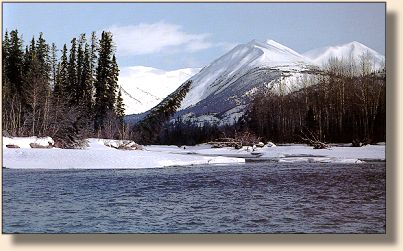
Rainbow trout are found throughout the Kenai River but the sections commonly associated
with trout fishing are the 18 miles of river from Kenai to Skilak Lake and the ensuing four
miles downstream from Skilak Lake to the vicinity of the Upper Killey River. Not surprisingly
most of this area is included in the Kenai River trophy trout management area. The
exception being that section of river downstream from Skilak Lake.
Regulations
If you do choose to fish the Kenai without a guide, pay close attention to the Alaska
sport fishing regulations. They are available wherever you purchase your license, and
you should take the time to become familiar with them. At first they may seem daunting,
and many non-resident, and even resident anglers, complain that they are too complex
and confusing . . .The thickness of the regulation booklet is what's intimidating, so don't
bother with it all. Take a look at the two or three pages of statewide regulations and
then go directly to the section on the Kenai Peninsula, and more specifically, the Kenai
River. Along with the regulations are detailed maps with which you should also become
familiar. If you don't it will be tough to make any sense out of the regulations. This
may seem very simple and logical but many anglers do not take the time to do it.
If you don't, you could easily break some rules. For instance, say you have a
productive September morning and put three silver salmon in the cooler. The
fishing was fast and furious and you figured you may as well ice down a few to
share with family and friends, and then do a little catch and release fishing or maybe
hunt for some rainbows and dollies with a lighter outfit. Wrong. In the
regulations it says, "No person after taking a bag/possession limit of three coho
salmon 16 inches or more in length from the Kenai River, may fish for any species
in the Kenai River on the same day."
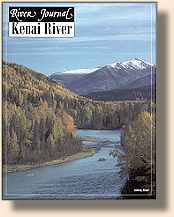
It's there in plain and simple English, and I am amazed at the number of visiting
anglers - and even resident anglers who have fished the Kenai for years - that
don't take 15 minutes to read the rules. And be forewarned, I regularly meet
Fish & Game enforcement officers along the Kenai River and its tributaries.
Sometimes they are wearing uniforms and riding in a well-marked truck, other
times they are on the stream dressed like everybody else. ~ Anthony Route
For a MAP of the Kenai, click
here.
For the FLIES for the Kenai, click
here.
To ORDER Kenai direct from the publisher, click
HERE.
Credits: From theKenai River, part of the River
Journal series, published by Frank Amato Publications.
We greatly appreciate use permission.
|







 Meanwhile the blue-green tinted water of the Kenai remained an unknown. It
wasn't until later - essentially the 1960s - when anglers realized that the silted
water of the Kenai River could be fished with lure or fly just as successfully as
clearer, most traditional looking, waters could.
Meanwhile the blue-green tinted water of the Kenai remained an unknown. It
wasn't until later - essentially the 1960s - when anglers realized that the silted
water of the Kenai River could be fished with lure or fly just as successfully as
clearer, most traditional looking, waters could.
 Fly fishers who fish for king salmon generally agree that getting the fly in front of the fish
is much more important than the fly pattern that is being used. Bright or fluorescent
orange - often in combination with fluorescent green or chartreuse - is the dominate
color of flies used for kings. In short, anything big and orange is considered a suitable
fly for kings. A prototypical fly that does a good job of capturing the spirit of fly fishing
for Kenai River king salmon is an obnoxious pattern called the Fat Freddie. It's a golf
ball-sized clump of orange yarn with a plume of white marabou - and maybe a spritzer
of silver Krystal Flash - tied on a 1/0 hook. For the FLIES for the Kenai, click
Fly fishers who fish for king salmon generally agree that getting the fly in front of the fish
is much more important than the fly pattern that is being used. Bright or fluorescent
orange - often in combination with fluorescent green or chartreuse - is the dominate
color of flies used for kings. In short, anything big and orange is considered a suitable
fly for kings. A prototypical fly that does a good job of capturing the spirit of fly fishing
for Kenai River king salmon is an obnoxious pattern called the Fat Freddie. It's a golf
ball-sized clump of orange yarn with a plume of white marabou - and maybe a spritzer
of silver Krystal Flash - tied on a 1/0 hook. For the FLIES for the Kenai, click
